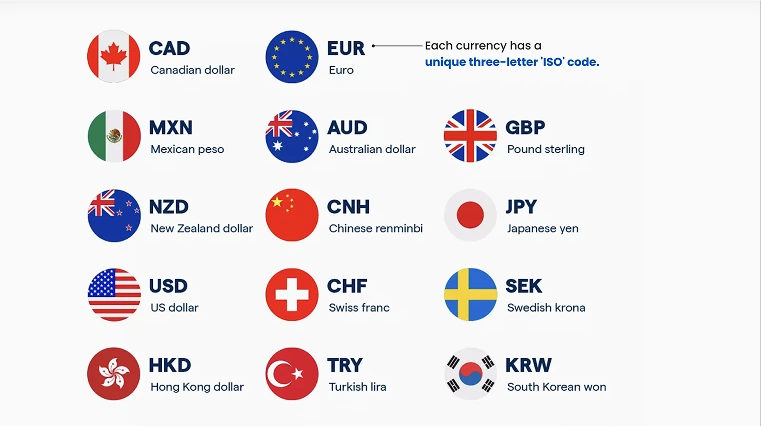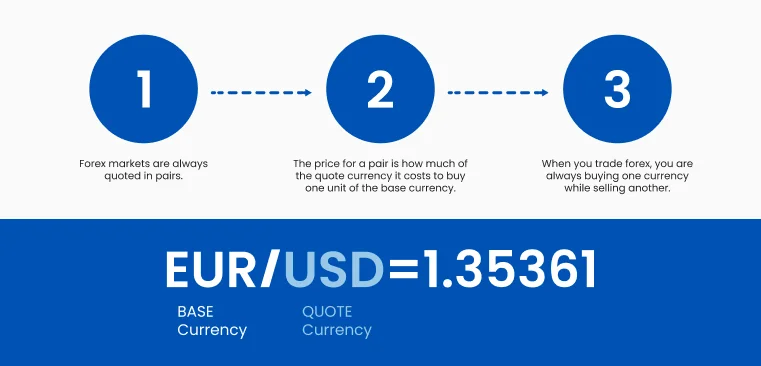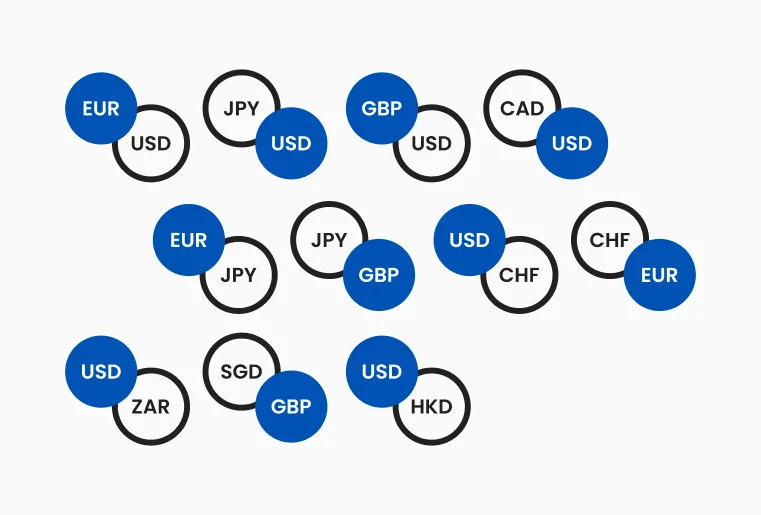

What is Forex Trading and How Does It Work
Forex trading, also known as foreign exchange or FX, is the decentralized global marketplace where the world's currencies are exchanged. It is the largest and most liquid financial market globally, with a daily trading volume exceeding $9.6 trillion. Unlike stock markets, there is no central exchange; instead, forex trading is conducted electronically over-the-counter (OTC) between participants worldwide.
Key Takeaways
The forex market operates 24 hours a day, five days a week
Currencies always trade in pairs (e.g. EUR/USD); you are simultaneously buying one and selling another
In forex trading, you can profit from prices rising (going long) or prices falling (going short).
Leverage allows traders to control large market positions with a relatively small deposit of capital
What is Forex Trading?
Forex trading, also known as foreign exchange or FX trading, is the simultaneous act of buying one currency and selling another. All forex trades happen in pairs, such as EUR/USD.
While some of this currency exchange happens for practical reasons, like international business or tourism, the vast majority of market activity is for speculation.
This means traders buy and sell currencies with the specific goal of profiting from changes in their exchange rates.
Real-World Example of Currency Exchange
To understand what is forex trading in simple terms, consider the standard currency exchange process. When you travel to Japan, you exchange your home currency (e.g. US Dollars) for Japanese Yen.
You have effectively participated in the forex market. You sold Dollars and bought Yen.
If you stay in Japan for a week and the value of the Yen rises against the Dollar while you are there, when you exchange your leftover Yen back to Dollars at the end of the trip, you will receive more Dollars than you started with, That difference is your profit.
Speculation vs Hedging
There are two primary motivations for participants in the forex market:
- Hedging: Multinational corporations use forex hedging to protect themselves against unfavorable currency price changes that could hurt their business operations.
- Speculation: Most retail traders engage in forex trading solely to make a profit from fluctuations in exchange rates.
How Does Forex Trading Work?
When you engage in forex trading as a speculator, you are essentially buying "shares" in a particular country's economy. You buy a currency based on the belief that its economy will strengthen relative to another country's economy.
Going Long vs. Going Short
One of the unique benefits of forex trading compared to traditional stock investing is the ease with which you can profit from falling prices.
Going Long (Buy): You buy a currency pair if you believe the first currency (base) will rise in value against the second currency.
Going Short (Sell): You sell a currency pair if you believe the first currency will fall in value. This allows traders to potentially profit even during economic downturns.
Step-by-Step Example of a Forex Trade
Let's walk through a practical example of how forex trading works using the EUR/USD pair.
- Selection: You select EUR/USD at a price of 1:1000.
- Analysis: You decide to Go Long (Buy)
- Action: You buy 1 Standard Lot (100,000 units)
- The Result: The price rises to 1.1050 (50pips)
- The Profit: The price moved 50 "pips" in your favor. On a standard lot, this equates to a profit of approximately $500.
Forex Trading Terminology: Pairs, Spreads, and Pips
To fully grasp what is forex trading, you must understand the key terminology and mechanics that define every transaction.
What are Currency Pairs?
In forex trading, currencies are always quoted in pairs, such as EUR/USD or GBP/JPY, also known as forex pairs. This is because in every foreign exchange transaction, you are simultaneously buying one currency and selling another.
Base Currency
The first currency listed in the pair (e.g. EUR/USD). This is the currency you are buying are selling.
Quote Currency
The second currency listed (e.g. EUR/USD). This tells you how much of this currency is needed to but one unit of the base currency.
The most frequently traded pairs are known as the "Majors," and they always include the US Dollar (e.g., EUR/USD, GBP/USD, USD/JPY).
Understanding Currency Pair Quotes
Every currency pair quote includes two prices:
- Bid price: The price at which you can sell the base currency
- Ask price: The price at which you can buy the base currency
The difference between these prices is known as the spread, and it represents one of the primary transaction costs in forex trading.
Base and Quote Currencies
Figure 3: Illustrates Base and Quote Currencies
In the currency pair EUR/USD:
- EUR is the base currency
- USD is the quote currency
The exchange rate indicates how much-quoted currency (USD) is needed to purchase one unit of base currency (EUR). For example, if EUR/USD is quoted at 1.2000, 1 euro can be exchanged for 1.20 US dollars.
What is Pips and Lots in Forex?

Figure 4: Illustrates One Pip
What is a Pip in Forex?
A forex pip (percentage in point) is the smallest standardized price movement in forex trading:
- For most currency pairs: a 0.0001 change in price (fourth decimal place)
- For pairs involving Japanese yen: a 0.01 change in price (second decimal place)
For example, if EUR/USD moves from 1.2000 to 1.2001, it has moved one pip. Pipettes (or fractional pips) represent a 1/10 of a pip and are shown as the fifth decimal place in most currency pairs.
How to Calculate Pips in Forex?
For the calculation of pips, find the difference between two price levels. In most currency pairs, the fourth decimal represent one pip. With pairs with USD as the quote currency (EUR/USD, for example), the pip value is calculated by multiplying the lot size by 0.0001.
For pairs where the USD is the base currency (like USD.EUR), divide 0.0001 by the current exchange rate then multiply by lot size.
Example of Pip Value Calculation for a Standard Lot
Currency Pair Example: EUR/USD
Position Size: 1 standard lot = 10,000 EUR
Exchange Rate= 1.2000
One Pip Movement (0.0001)= 100,000 X 0.0001 =US$10
If you trade a mini lot (10,000 units), one pip=US$1.
If you trade a micro lot (1,000 units), one pip= US$0.10
What is a Lot in Forex Trading?
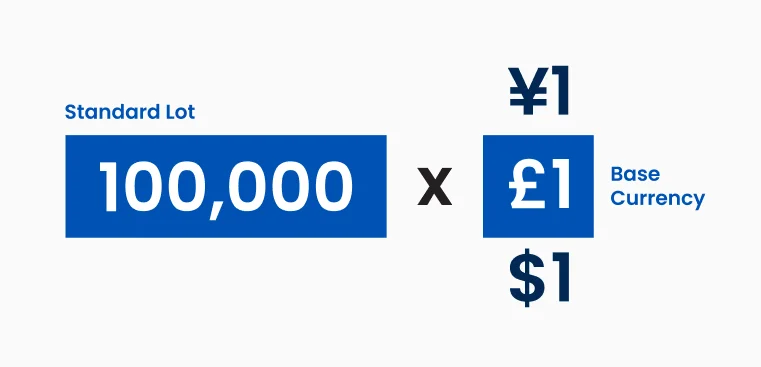
Figure 5: Illustrates One Lot
In forex trading, a lot refers to the standardized unit of measurement for trade size, with one standard lot equal to 100,000 units of the base currency. The size of the lot directly impacts the value of a pip. For a standard lot of EUR/USD, each pip movement represents a $10 change in value.
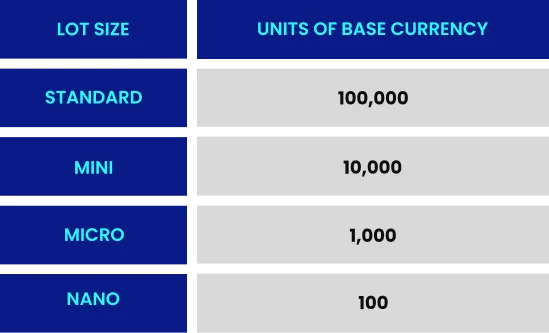
Calculating Profit and Loss
To calculate potential profit or loss in forex trading:For a long position (buying): Profit/Loss = (Closing Price - Opening Price) × Lot Size × Number of Lots
For a short position (selling): Profit/Loss = (Opening Price - Closing Price) × Lot Size × Number of Lots
Example Calculation
Trading scenario:
Currency pair: EUR/USD
Opening position: Buy 1 standard lot (100,000 units) at 1.2000
Closing position: Sell at 1.2050
Calculation: (1.2050 - 1.2000) × 100,000 = $500 profit
What is a Forex Trader?
A forex trader is someone who participates in the forex market by buying and selling currency pairs, with the objective of making profits from change in exchange rates. Traders may be individual retail traders or institutional traders, such as banks and hedge funds.
How to Become a Forex Trader?
There are several key steps you should do to become a forex trader:
1. Learn the fundamentals
Research, study, and understand key concepts involved in forex trading, such as currency pairs, pips, lots, spreads, leverage, margin, and how the market works. TMGM’s Trading Academy provides comprehensive coverage on these topics.
2. Choose a trading broker that is reputable
To trade forex online, you will require a trading broker. To ensure the most safe and reliable one, ensure it is regulated, licensed and provides clear fee structures. TMGM fits all these criteria.
3. Open and set up a trading account
Start with a paper trading account, which has virtual funds you can use to practice trading first, without the risk of losing real money. TMGM has a demo account with virtual funds and enables you to trade real forex pairs but without the monetary risk.
4. Start trading with smaller lots and scale up
Once you are ready to start trading, use small lot sizes, which limit your risk and avoid high leverage first. Once you’re comfortable with your trading ability, you can start to scale up.
5. Continue learning about forex trading as you go
Stay informed about the market, the latest news, economic decisions, and central bank announcements, and improve your strategy over time.
What is Leverage and Margin in Forex Trading?
What is Leverage in Forex?
Leverage allows forex traders to control a large position with a relatively small capital. It is expressed as a ratio, such as 30:1, which means you can maintain a position 30 times larger than your invested capital.
Leverage is a double-edged sword:
- It magnifies potential profits from favorable market movements
- It equally magnifies potential losses from adverse market movements
What is Margin in Forex Trading?
Margin in forex is the deposit required to open and maintain a leveraged position. It acts as collateral for the leveraged portion of the trading exposure.
Types of Margin
- Initial Margin: The percentage of the full trade value required to open a position. For example, with 30:1 leverage, the initial margin requirement would be 3.33% of the total position value.
- Maintenance Margin: The minimum account balance required to keep a position open. If your account equity falls below this level due to losses, you may receive a margin call requiring additional funds, or your positions may be automatically closed (stopped out).
How to Calculate Margin in Forex Trading
For a EUR/USD trade with:
- Position size: 1 standard lot (100,000 EUR)
- Current exchange rate: 1.2000
- Position value in USD: 120,000
- Leverage: 30:1
- Initial margin requirement: 120,000 ÷ 30 = $4,000
You need at least $4,000 in your account to open this position.
Risk Management with Leverage
Leverage in trading can amplify potential gains and losses, making risk management a crucial component of a sustainable strategy.
- Position Sizing: To mitigate excessive exposure, limit each trade to a small percentage of your total capital. A commonly recommended approach is risking no more than 1-2% per trade.
- Stop-Loss Orders: Always use stop-loss orders to define the maximum acceptable loss for each trade, ensuring that sudden market movements do not lead to significant capital drawdowns.
- Risk-Reward Ratio: Prioritize trades with a favorable risk-reward ratio, typically aiming for at least 1:2. This ensures that successful trades can offset potential losses over time.
- Leverage Reduction: While brokers may offer high leverage, consider using less than the maximum available to reduce risk exposure and prevent unnecessary liquidation.
- Stress Testing: Assess how different market conditions, including high volatility, may impact leveraged positions. This helps forex traders prepare for unexpected price fluctuations and adjust strategies accordingly.
Effective leverage management ensures controlled risk exposure and long-term sustainability in trading.
What is a Forex Market
Forex trading is decentralized and operates over the counter (OTC). Instead of a central exchange, transactions occur electronically between banks, brokers, institutions, and retail traders.

Figure 6: Illustrates the forex transactions each day
The Evolution of Forex Trading
The modern forex market has undergone significant transformation since its origins:
Pre-1970s: Fixed exchange rates under the Bretton Woods Agreement
1971: Transition to floating exchange rates following the collapse of Bretton Woods
1980s-1990s: Introduction of electronic trading platforms and expanded institutional access
Early 2000s: Proliferation of online retail forex brokers, democratizing access for individual traders
Present day: Advanced algorithmic trading, mobile platforms, and integration with other asset classes
Today's forex market represents a sophisticated ecosystem where central banks, commercial banks, investment firms, corporations, and retail traders interact continuously across global markets.
What Moves the Forex Market?
Economic Factors
Central Bank Policies
Central banks are crucial in shaping monetary policy, directly influencing currency values. Interest rates are a primary tool
Economic Indicators
Key economic releases that influence forex markets: 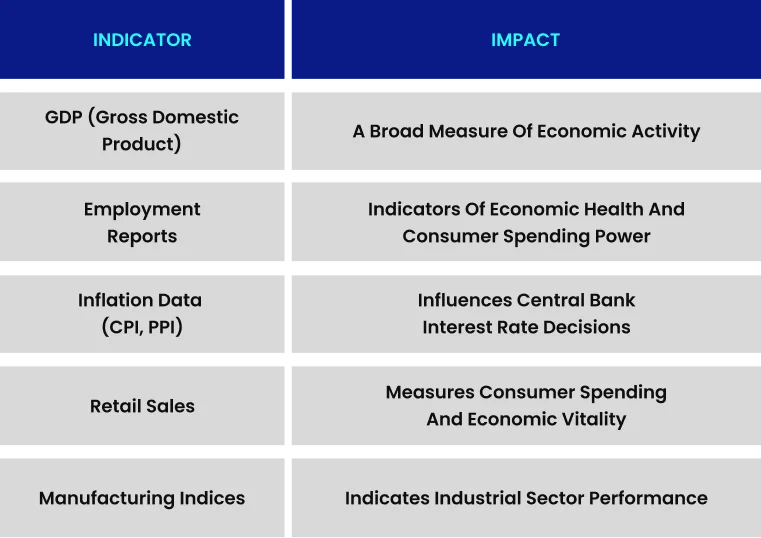
Geopolitical Events
- Elections: Political transitions can signal policy changes affecting currencies
- Trade Agreements/Disputes: Impact economic relationships between countries
- Regional Conflicts: Create uncertainty and risk aversion in markets
- Regulatory Changes: New financial regulations can affect capital flows
Market Psychology
Market Sentiment
Market sentiment reflects traders' overall attitude, influencing price movements beyond fundamental data. It plays a crucial role in short-term trends and momentum-driven markets.
Trade Forex with TMGM
TMGM is a leading forex broker offering exceptional trading conditions, advanced technology, and comprehensive support for traders of all levels.
Why Choose TMGM for Forex Trading
TMGM is a leading forex broker offering exceptional trading conditions, advanced technology, and comprehensive support for traders of all levels.
TMGM offers tight spreads starting from 0.0 pips on major currency pairs with competitive commission rates. Traders can access leverage up to 1:1000, benefiting from deep liquidity sourced from multiple tier-1 providers for efficient trade execution. The platform provides fast execution speeds, averaging under 30 milliseconds, minimizing slippage, and improving trading efficiency.
TMGM supports MetaTrader 4 (MT4) and MetaTrader 5 (MT5), available on pc, mac, tablet and mobile devices, catering to various trading preferences. The broker provides educational resources, including a Trading Academy, live webinars, daily market analysis, trading guides and a real-time economic calendar to keep traders informed. Clients also receive multilingual support, dedicated account managers, and efficient withdrawal processing, ensuring a seamless trading experience.
Free Forex Trading Courses and Resources
Becoming a successful Forex trader takes skill, knowledge, and practice. TMGM offers everything you need to get there, with a wealth of free forex trading courses and webinars. It also offers a free demo account with US$100,000 in virtual funds to help build your confidence in a risk-free environment.
We also provide trading strategy insights, market analysis, and new articles for all experience levels-so whether you're a complete newcomer or a seasoned trader, TMGM has something for you. Sign up for an account today!
Trade Smarter Today




Frequently Asked Questions
What Does Forex (FX) Trading mean?
Is there a difference between forex trading and currency trading?
How can I make money from forex trading?
How can I get started trading forex?
What costs and fees do you have to pay when trading forex?


Account
Account
Instantly

